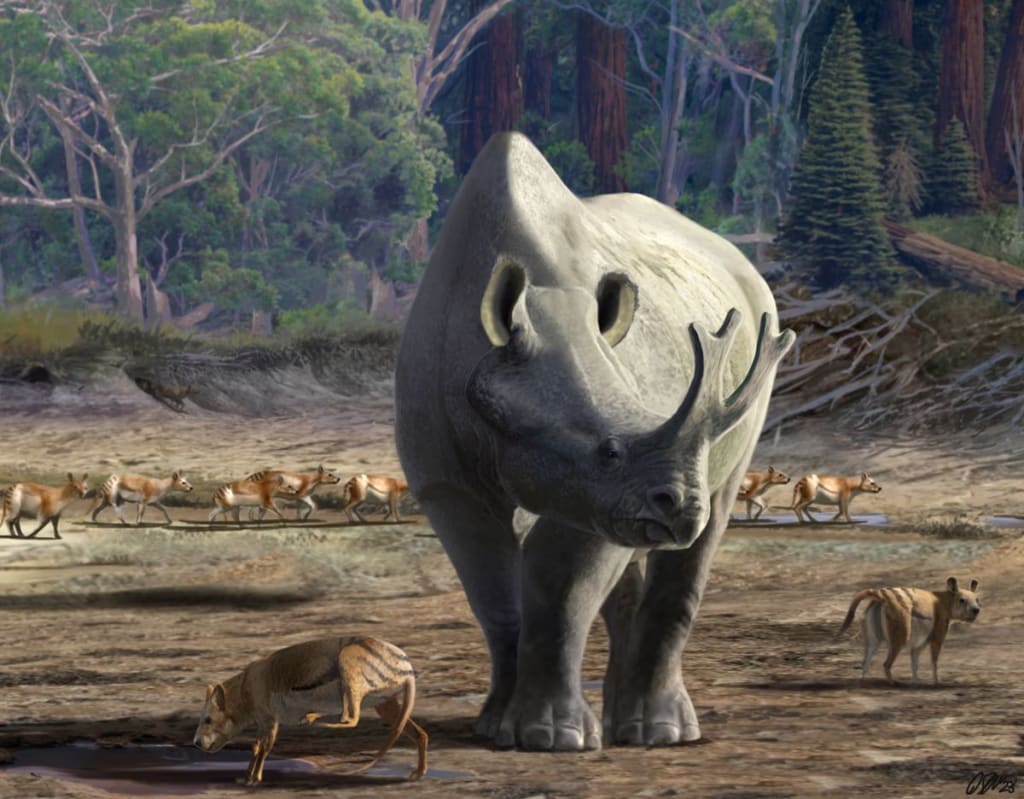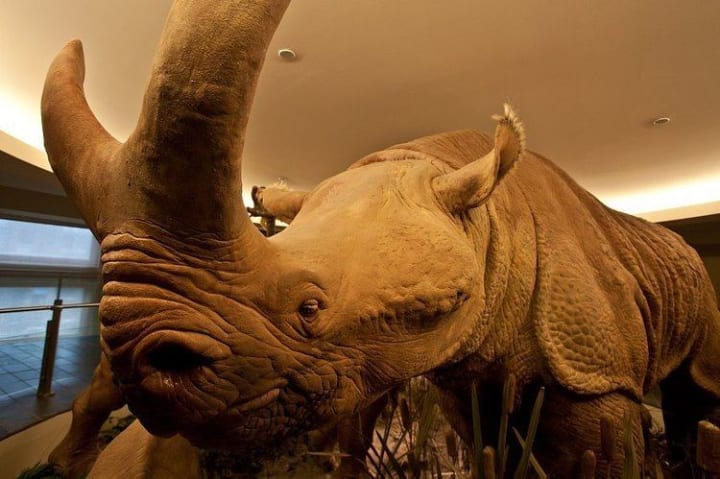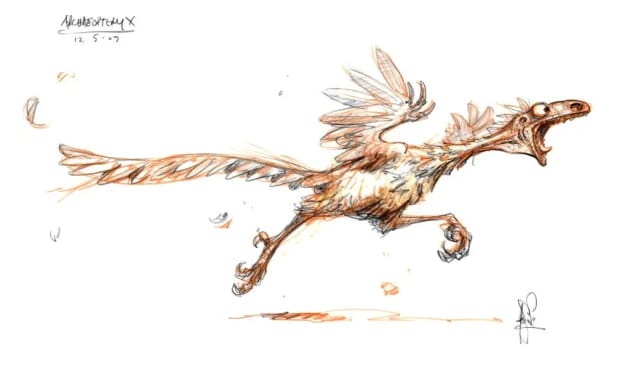Megacerops: A Glimpse into the Ancient Past
ancient animal

Introduction
Megacerops, often known by its older name Brontotherium, is an extinct genus of odd-toed ungulates (perissodactyls) that roamed North America during the late Eocene epoch, approximately 37 to 34 million years ago. These massive, rhinoceros-like creatures are a fascinating subject for paleontologists and enthusiasts alike due to their unique characteristics, evolutionary significance, and the rich fossil record they left behind. This blog explores the detailed history, ecology, and evolution of Megacerops, providing a comprehensive understanding of this remarkable genus.
Discovery and Nomenclature
Megacerops was first described in the 19th century, a period of fervent paleontological activity in North America. The name Megacerops, meaning "large horned face," is derived from Greek, referring to the prominent horn-like structures on their skulls. Initially, many different genera and species names were assigned to what are now considered various species within the Megacerops genus due to fragmentary and isolated fossil finds. Over time, as more complete specimens were discovered and studied, paleontologists were able to revise these classifications and consolidate many into the genus Megacerops.
Physical Characteristics
Megacerops were massive animals, with some species standing up to 2.5 meters (8.2 feet) at the shoulder and weighing as much as 3.5 tons. Their most distinctive feature was the pair of blunt, Y-shaped horns situated above the nose. Unlike the sharp horns of modern rhinoceroses, these were likely used for display and possibly for combat during mating rituals rather than for defense against predators.
The body of Megacerops was robust and sturdy, with thick legs designed to support their enormous weight. Their teeth were adapted for a diet of coarse vegetation, indicative of the dense forests and lush environments they inhabited.
Ecology and Habitat
Megacerops thrived in the late Eocene epoch, a period characterized by warm climates and extensive forests in North America. The ecosystem they inhabited was rich and diverse, supporting a wide range of flora and fauna. These animals likely played a significant role in their environment, both as mega-herbivores and as part of the prey-predator dynamic.
Diet
As herbivores, Megacerops primarily fed on a variety of vegetation available in their forested habitats. Their large, flat teeth were well-suited for grinding leaves, twigs, and possibly fruits. The structure of their teeth and jaws suggests they were not specialized feeders but rather generalists, capable of consuming a wide range of plant materials.
Social Behavior
While direct evidence of their social behavior is scarce, the morphology of their horns suggests that Megacerops may have engaged in intraspecific combat, similar to the behavior observed in modern-day deer and antelopes. These horn clashes could have been a way for males to establish dominance and gain mating rights. Fossil sites with multiple individuals suggest that they may have lived in groups, which would offer advantages in terms of protection and social interactions.
Predators
Despite their size, adult Megacerops had few natural predators. Juveniles and weaker individuals, however, could fall prey to large Eocene predators such as Hyaenodon, a formidable carnivore of the time. The massive size and potentially aggressive nature of adult Megacerops likely deterred many predators.
Evolutionary Significance

Megacerops belongs to the family Brontotheriidae, an extinct group of large, rhinoceros-like perissodactyls. The evolutionary history of this family provides significant insights into the adaptive radiation and ecological roles of large herbivores in prehistoric times.
Early Evolution
The earliest ancestors of Megacerops appeared in the early Eocene epoch, around 56 million years ago. These early brontotheres were smaller and less specialized than their later relatives. Over millions of years, they evolved into larger forms with more pronounced cranial features, culminating in the emergence of the genus Megacerops.
Adaptive Radiation
The diversification of brontotheres, including Megacerops, is a prime example of adaptive radiation. This process, where a single ancestral species rapidly diversifies into multiple forms to exploit different ecological niches, is evident in the varied morphology of brontothere species. Their evolution showcases how environmental pressures and ecological opportunities can drive the development of distinctive physical traits and behaviors.
Extinction
Megacerops and its relatives went extinct at the end of the Eocene epoch, around 34 million years ago. This extinction event is part of a broader pattern of climatic and environmental changes that occurred during the transition from the Eocene to the Oligocene epochs. The cooling climate, along with the spread of grasslands and the decline of dense forests, likely played a crucial role in their extinction. As their preferred habitats dwindled, so did their populations, leading to their eventual disappearance from the fossil record.
Fossil Record and Paleontological Insights
The fossil record of Megacerops is extensive, with numerous specimens found across North America. These fossils have provided valuable insights into the anatomy, behavior, and ecology of these ancient creatures.
Major Fossil Sites
Significant fossil sites for Megacerops include the Badlands of South Dakota, Nebraska, and Wyoming. These sites have yielded well-preserved skeletons and skulls, allowing paleontologists to reconstruct the physical appearance and infer the behavior of Megacerops.
Contributions to Science
The study of Megacerops fossils has contributed to our understanding of Eocene ecosystems and the evolutionary history of perissodactyls. By analyzing the morphology of Megacerops and comparing it with other brontotheres, scientists have been able to piece together the phylogenetic relationships within the Brontotheriidae family. Additionally, the study of wear patterns on their teeth has provided insights into their diet and feeding behavior.
Challenges and Controversies
Despite the wealth of fossils, there are still challenges and controversies in the study of Megacerops. One ongoing debate revolves around the function of their horns. While many paleontologists believe they were used for intraspecific combat, others suggest they could have been for display or species recognition. Additionally, the exact reasons for their extinction remain a topic of research, with various hypotheses being proposed.
Legacy and Cultural Impact
The imposing appearance and intriguing nature of Megacerops have captured the imagination of both scientists and the public. They have become iconic representatives of prehistoric life and are frequently featured in museum exhibits and educational materials.
Museums and Exhibits
Many natural history museums across North America and beyond have Megacerops skeletons on display. These exhibits provide the public with a tangible connection to the ancient past and help promote interest in paleontology and natural history.
Media and Popular Culture
Megacerops has also appeared in various forms of media, including documentaries, books, and even video games. Their dramatic appearance and the mystery surrounding their lives make them popular subjects for stories about prehistoric life.
Conclusion
Megacerops, with its massive size, distinctive horns, and rich fossil record, offers a fascinating glimpse into the prehistoric world. Their history, ecology, and evolution provide valuable insights into the dynamics of ancient ecosystems and the processes of evolutionary change. As we continue to study these remarkable creatures, they not only enhance our understanding of the past but also inspire curiosity and wonder about the history of life on Earth. Through ongoing research and public engagement, the legacy of Megacerops lives on, reminding us of the diverse and ever-changing tapestry of life that has existed on our planet.
About the Creator
Enjoyed the story? Support the Creator.
Subscribe for free to receive all their stories in your feed. You could also pledge your support or give them a one-off tip, letting them know you appreciate their work.






Comments
There are no comments for this story
Be the first to respond and start the conversation.